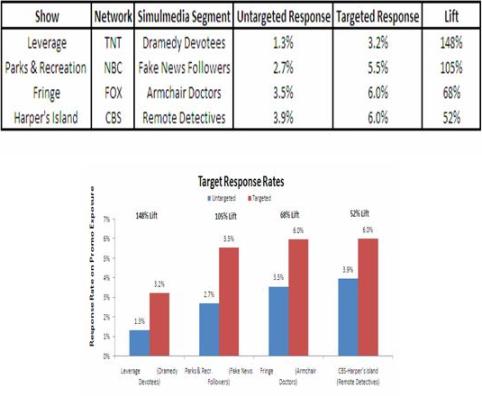Simulmedia Targeting Improves Promotion Efficacy - Stewart Hauser - MediaBizBlogger

Simulmedia sells provable incremental TV viewership. We identify the right available audiences for specific shows, we locate them, and we get them to tune in.
The chart below demonstrates the benefit of using Simulmedia Segments™ targeting in promotional plans, based on results of an internal study of recently launched programs. Using anonymous set top box data, we first examined promotion exposure by segment during the eight weeks prior to the show's original air date. We then looked at the first episode of the program and examined average tune-in for two different groups: Overall audience exposed to the promotions, and Simulmedia Segments™ exposed to the promotions and previously designated as the most receptive to these programs.

Results show that Simulmedia's data-driven predictive models consistently have a higher response rate than existing promotion plans. Furthermore, the targeted and untargeted exposed groups watched the same amount of the given network in the preceding eight weeks, suggesting that the response discrepancy is, indeed, the result of our targeting rather than simply the result of differences in television consumption.
Targeted advertising works, and moreover, the benefits are widespread. Advertisers clearly benefit, as they can efficiently target their desired audiences rather than wasting money on audiences that are unlikely to respond to the promotions. Viewers benefit as well. They are reminded about shows that they already like and are informed about new shows that they would probably enjoy. Targeted advertising even helps the TV networks that carry the promotions, since viewers are less likely to change the channel during a commercial, and potentially not return to that network, if they are intrigued by the programs advertised in the promotions.
The key remaining question, particularly for advertisers, is how to most efficiently target the desired audiences. Online advertisers can pinpoint specific individuals who just bought a dog, or a home, or just got married, and can advertise accordingly, spending money to reach only the users who are most likely to respond to the ads. Television advertising is more difficult. Target audiences can be located and reached, but only by also reaching viewers who are less likely to respond. Everyone—viewers, advertisers, networks—loses when advertisements are shown to the wrong people. Through continued data collection and analysis, we can work to reduce this waste and improve the situations of numerous parties in the television world.


